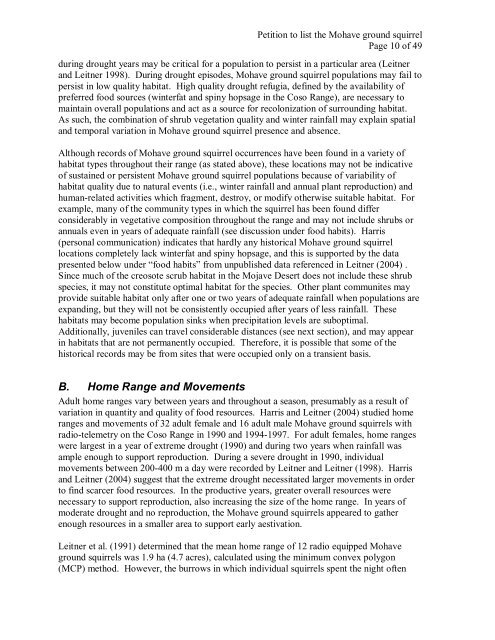Petition to list the Mohave Ground Squirrel - Defenders of Wildlife
Petition to list the Mohave Ground Squirrel - Defenders of Wildlife
Petition to list the Mohave Ground Squirrel - Defenders of Wildlife
Create successful ePaper yourself
Turn your PDF publications into a flip-book with our unique Google optimized e-Paper software.
<strong>Petition</strong> <strong>to</strong> <strong>list</strong> <strong>the</strong> <strong>Mohave</strong> ground squirrel<br />
Page 10 <strong>of</strong> 49<br />
during drought years may be critical for a population <strong>to</strong> persist in a particular area (Leitner<br />
and Leitner 1998). During drought episodes, <strong>Mohave</strong> ground squirrel populations may fail <strong>to</strong><br />
persist in low quality habitat. High quality drought refugia, defined by <strong>the</strong> availability <strong>of</strong><br />
preferred food sources (winterfat and spiny hopsage in <strong>the</strong> Coso Range), are necessary <strong>to</strong><br />
maintain overall populations and act as a source for recolonization <strong>of</strong> surrounding habitat.<br />
As such, <strong>the</strong> combination <strong>of</strong> shrub vegetation quality and winter rainfall may explain spatial<br />
and temporal variation in <strong>Mohave</strong> ground squirrel presence and absence.<br />
Although records <strong>of</strong> <strong>Mohave</strong> ground squirrel occurrences have been found in a variety <strong>of</strong><br />
habitat types throughout <strong>the</strong>ir range (as stated above), <strong>the</strong>se locations may not be indicative<br />
<strong>of</strong> sustained or persistent <strong>Mohave</strong> ground squirrel populations because <strong>of</strong> variability <strong>of</strong><br />
habitat quality due <strong>to</strong> natural events (i.e., winter rainfall and annual plant reproduction) and<br />
human-related activities which fragment, destroy, or modify o<strong>the</strong>rwise suitable habitat. For<br />
example, many <strong>of</strong> <strong>the</strong> community types in which <strong>the</strong> squirrel has been found differ<br />
considerably in vegetative composition throughout <strong>the</strong> range and may not include shrubs or<br />
annuals even in years <strong>of</strong> adequate rainfall (see discussion under food habits). Harris<br />
(personal communication) indicates that hardly any his<strong>to</strong>rical <strong>Mohave</strong> ground squirrel<br />
locations completely lack winterfat and spiny hopsage, and this is supported by <strong>the</strong> data<br />
presented below under “food habits” from unpublished data referenced in Leitner (2004) .<br />
Since much <strong>of</strong> <strong>the</strong> creosote scrub habitat in <strong>the</strong> Mojave Desert does not include <strong>the</strong>se shrub<br />
species, it may not constitute optimal habitat for <strong>the</strong> species. O<strong>the</strong>r plant communites may<br />
provide suitable habitat only after one or two years <strong>of</strong> adequate rainfall when populations are<br />
expanding, but <strong>the</strong>y will not be consistently occupied after years <strong>of</strong> less rainfall. These<br />
habitats may become population sinks when precipitation levels are suboptimal.<br />
Additionally, juveniles can travel considerable distances (see next section), and may appear<br />
in habitats that are not permanently occupied. Therefore, it is possible that some <strong>of</strong> <strong>the</strong><br />
his<strong>to</strong>rical records may be from sites that were occupied only on a transient basis.<br />
B. Home Range and Movements<br />
Adult home ranges vary between years and throughout a season, presumably as a result <strong>of</strong><br />
variation in quantity and quality <strong>of</strong> food resources. Harris and Leitner (2004) studied home<br />
ranges and movements <strong>of</strong> 32 adult female and 16 adult male <strong>Mohave</strong> ground squirrels with<br />
radio-telemetry on <strong>the</strong> Coso Range in 1990 and 1994-1997. For adult females, home ranges<br />
were largest in a year <strong>of</strong> extreme drought (1990) and during two years when rainfall was<br />
ample enough <strong>to</strong> support reproduction. During a severe drought in 1990, individual<br />
movements between 200-400 m a day were recorded by Leitner and Leitner (1998). Harris<br />
and Leitner (2004) suggest that <strong>the</strong> extreme drought necessitated larger movements in order<br />
<strong>to</strong> find scarcer food resources. In <strong>the</strong> productive years, greater overall resources were<br />
necessary <strong>to</strong> support reproduction, also increasing <strong>the</strong> size <strong>of</strong> <strong>the</strong> home range. In years <strong>of</strong><br />
moderate drought and no reproduction, <strong>the</strong> <strong>Mohave</strong> ground squirrels appeared <strong>to</strong> ga<strong>the</strong>r<br />
enough resources in a smaller area <strong>to</strong> support early aestivation.<br />
Leitner et al. (1991) determined that <strong>the</strong> mean home range <strong>of</strong> 12 radio equipped <strong>Mohave</strong><br />
ground squirrels was 1.9 ha (4.7 acres), calculated using <strong>the</strong> minimum convex polygon<br />
(MCP) method. However, <strong>the</strong> burrows in which individual squirrels spent <strong>the</strong> night <strong>of</strong>ten
















